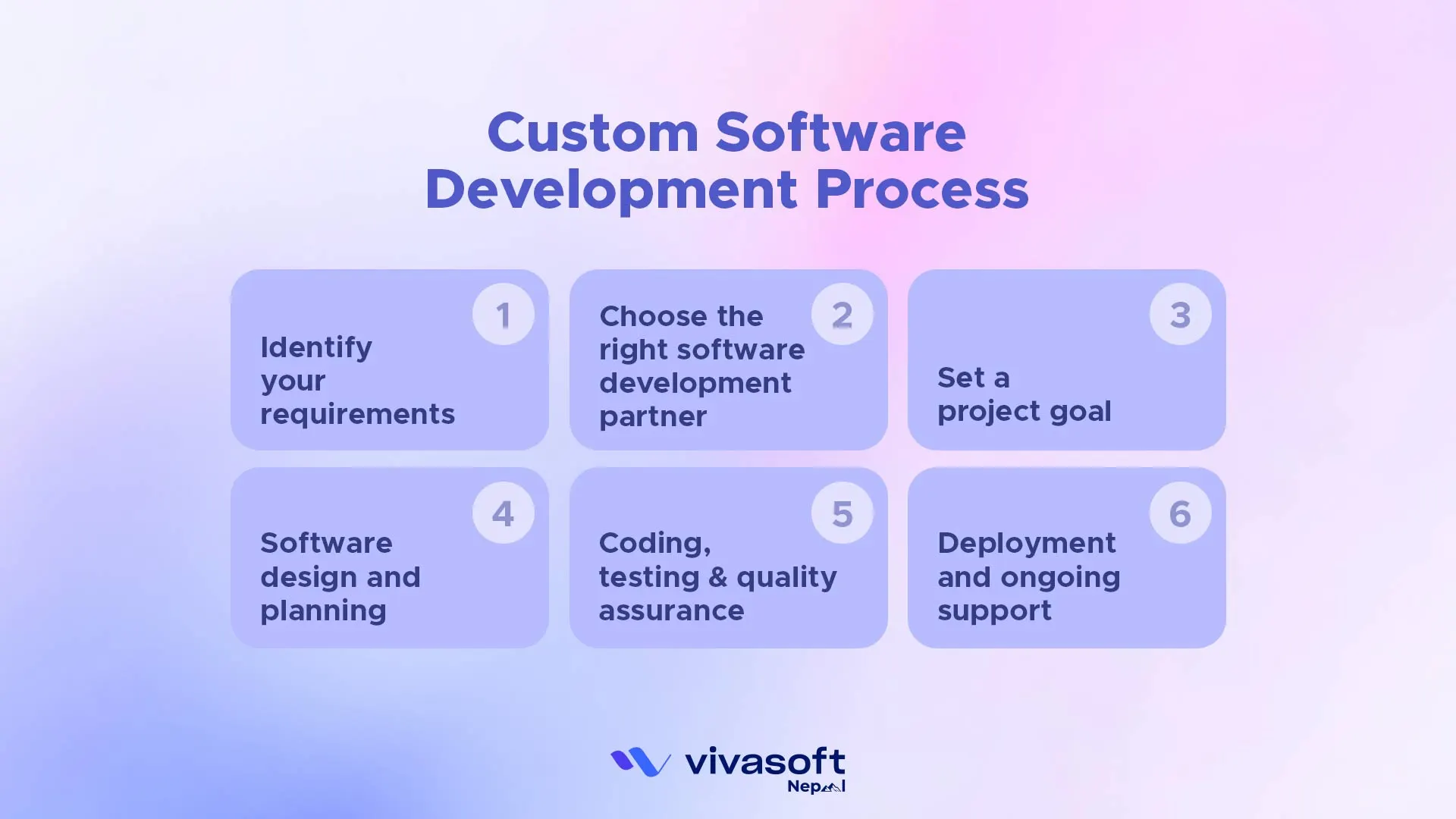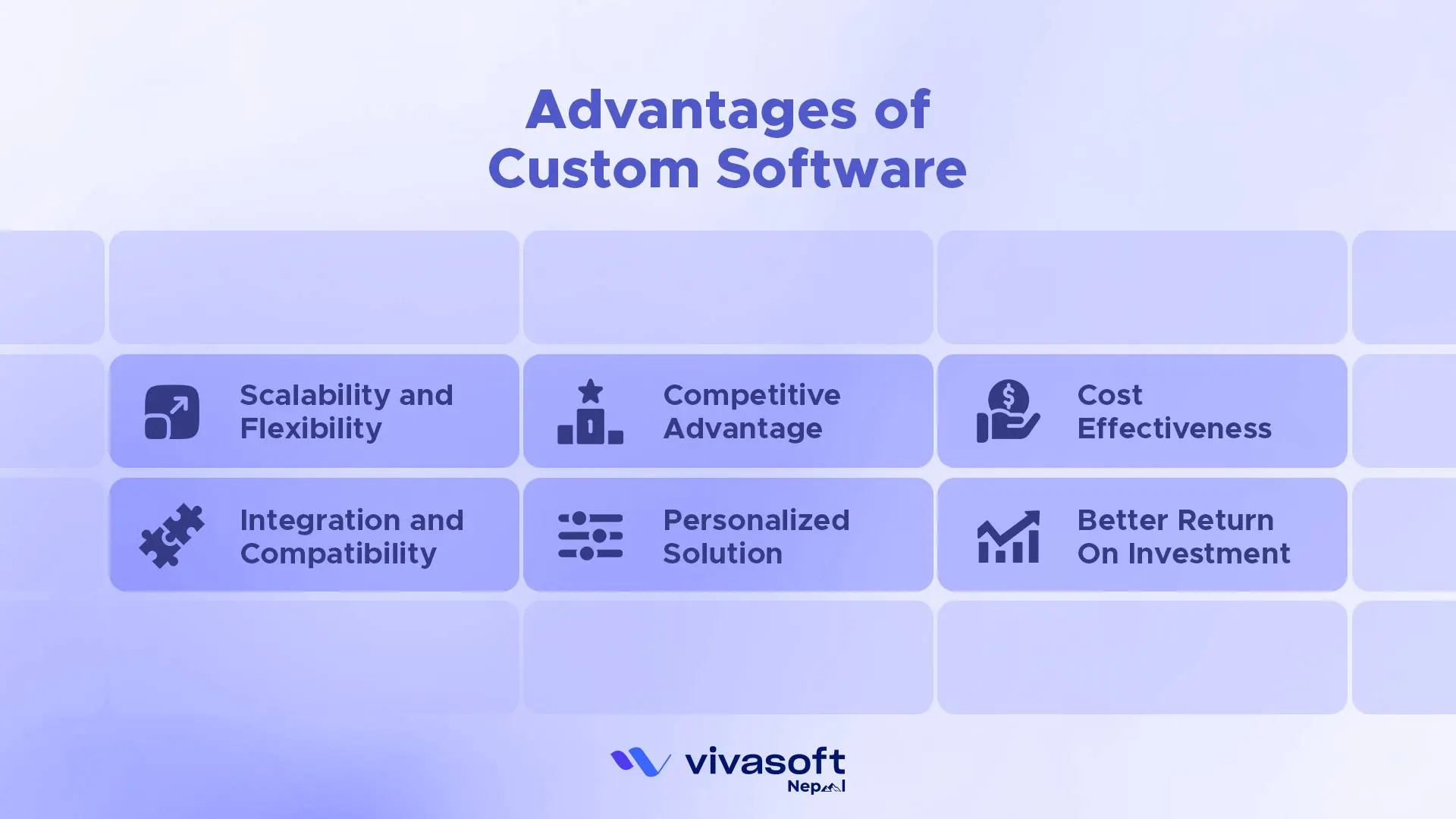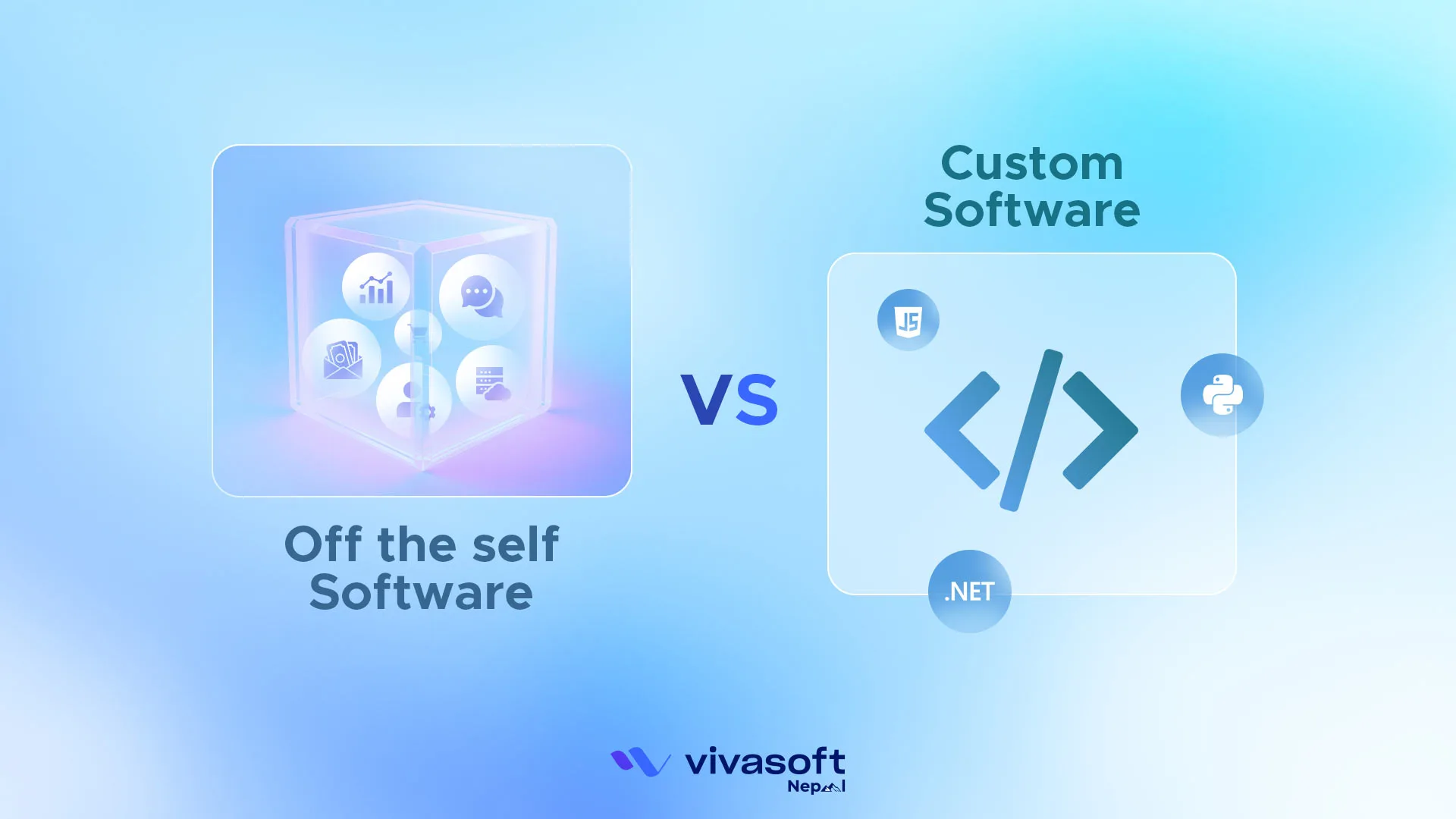Studies show that up to 60% of businesses struggle with software that fails to meet their needs. It is often because of various technical and operational issues, which cause delays and resource wastage. Business often gets stuck in choosing the best option between off-the-shelf vs custom software in Nepal.
Off-the-shelf software is a pre-built solution that offers quick setup. But it often lacks the customization options needed. Conversely, custom software is designed specifically for your unique business goals. It effectively matches your processes and local market demands.
Both software solutions have notable advantages and drawbacks depending on your goals and budget. Read to get to know the key differences to decide which software approach is best for your business in Nepal.
What is Off the Shelf Software?
Off-the-shelf software is mainly a pre-built program that is designed for general business use. Users have the flexibility to purchase and use it immediately without any development hassle.
The software is designed for some generic purpose covering accounting, customer management, or payroll. Basically, businesses with simple and standard operations and a minimal budget for custom-built software can go with this software.
You will find popular examples such as Microsoft Office, SAP ERP, and HubSpot CRM.
However, you will likely get the limited customization. Often it lacks the reliability for your unique business workflows but can be good starting stable solutions with regular updates from the vendor.
What are the Pros and Cons of Off the Shelf Software?
Pros
- Lower Initial Cost: Off-the-shelf software costs less as the development expenses are spread across many users. It is best suitable for small businesses with a tight budget in Nepal.
- Quick Implementation: You have the opportunity to deploy the software immediately after purchase. You can run fast-moving markets or urgent business needs.
- Proven Reliability: Almost all of the off-the-shelf products go through professional testing and have millions of users worldwide. You can be assured of having a stable and secure performance.
- Community and Vendor Support: You get access to large user communities and professional support. It helps resolve any rising software issues faster.
- Regular Updates: Vendors offer ongoing updates that improve functionality and security. You can keep your system correct without much effort.
Cons
- Fewer customization Options: It is common for businesses facing hurdles with workflow challenges if they are using off-the-shelf software. It often affects efficiency if your workflows are unique.
- Scalability Issues: With the growing Nepal IT market, off-the-shelf solutions may struggle to support expanding operations.
- Integration Challenges: It is another hurdle for companies while integrating off-the-shelf software with legacy systems. Delays are common in this instance.
- Hidden and Ongoing Costs: The added subscription add-on and licensing fees increase total costs. It makes the total cost higher than expected over time.
- Overload Features and Functions: Most of the software is designed with a range of features, some of which a business may never use. It is just a waste of resources.
What is Custom Software?
Custom software is a specialized solution that is built for a specific purpose. The software is designed to serve unique processes, goals, and challenges. It is far beyond the general software and adapts to your daily operations.
The software addresses the exact pain points with the changeable feature set. As the business expands, your software grows with you. Developers add modules for new services, automate manual processes, or connect with new partners.
Nepali businesses often face challenges like language barriers, local tax rules, and specific payment gateways. Custom software solutions help businesses to resolve these directly.
For instance, a retailer in Kathmandu will need a custom solution to track inventory. As needed, they can integrate with eSewa and generate VAT-compliant invoices.
Similarly, a healthcare provider will need a patient management system with local compliance features. It can also be integrated with national health databases.
What are the Differences Between Off the Shelf vs Custom Software?
Off-the-shelf software hardly equips unique features or can not be easily customized for the growing market demand. On the other hand, custom software is an effective asset that is specifically developed to meet your business’s unique requirements.
It offers unlimited customization opportunities for unique workflows and meets local regulations. Plus, businesses can ensure improved efficiency and find doors to new opportunities for success that they can’t see in the off-the-shelf software.
Aspect | Custom Software | Off-the-Shelf Software |
Initial Cost | High upfront investment ($100,000+) | Lower upfront cost ($1,000 – $100,000) |
Development Time | Several months to build and deploy | Immediate use after purchase |
Feature Fit | Customized to exact business needs | Generic, and only 10–15% of features are typically used |
Customization | Fully customizable with ongoing modifications | Limited customization within vendor options |
Scalability | Built to customize with your business growth | May require costly upgrades |
Integration | Sufficient integration with existing systems | Integration can be complex and costly |
User Interface (UI/UX) | Designed for your users’ preferences and workflows | Standardized UI may not suit specific users |
Ownership | Full ownership of source code and data | Software owned and controlled by the vendor |
Security | Custom security protocols tailored to needs | Standard security is shared among all users |
Maintenance & Support | Managed by your team or chosen developers | The vendor provides regular updates and support |
Long-term ROI | Higher ROI | Ongoing subscription/licensing fees may add up |
Business Adaptation | Software adjusts to your business processes | Businesses may need to compromise on the software limitations |
Custom Software Development Process
Custom software development offers a structured process to deliver solutions that are needed for your business. Some key steps of the development process include:

- Identify your requirements: First, you have to analyze your business needs and challenges. Define what problem your software must solve. Fix use case modeling, user stories, and requirements workshops to find the essential features.
- Choose the right software development partner: The next step is selecting a partner with proven experience, relevant skills. The better they have a strong understanding of your industry. Prefer partners experienced in agile frameworks and effective communication channels.
- Set a project goal: Define SMART objectives for your project. Then, set KPIs and timelines. It will make the project management process much more efficient.
- Software design and planning: The next step is creating technical design documents. This includes system architecture diagrams, data flow diagrams, and prototypes for the user interface. Also, finalize the technology stack, API design, and integration points.
- Coding, testing & quality assurance: At this phase, developers start with coding. They implement the software using version control systems and follow coding standards. Also ensure to design and implement the needed testing process to detect defects early.
- Deployment and ongoing support: Finally, plan for efficient deployment and minimize downtime. You can utilize effective processes this time. Such as the most used blue-green deployment or canary releases. After launch, maintain ongoing maintenance, monitoring, and regular updates.
What are the Advantages of Custom Software?
Custom software development provides distinct advantages that go beyond basic functionality. Though the initial investment seems a bit higher, the long-term benefits make it a strategic choice. Let’s highlight some unique offerings by the custom software:

- Scalability and Flexibility: Custom software is developed with modular design principles and scalable infrastructure. Often it utilizes cloud-native technologies such as microservices and containerization that dynamically adjust with your business growth. You can handle increased workloads and user demands.
- Competitive advantage: Custom solutions offer innovation beyond industry standards. Businesses get unique intellectual property integrated into their software. It sets the business or that specific service apart from competitors. You can implement unique functionalities such as advanced analytics or workflow automation that ensure a better UX.
- Cost-effectiveness: Research shows that businesses with custom solutions witness increased profit by up to 95%. It saves you from licensing fees and subscription costs. Even by automating specific business processes, you don’t have to struggle with manual workload and save on budget. It is up to 30% over time.
- Integration and compatibility: The software is typically designed with APIs, through which businesses can easily integrate with existing enterprise systems. You don’t need to manually enter the data and automate your workflow.
- Personalized solution: Every feature and module of custom software is customized for some specific business workflows. Moreover, the software equips advanced security protocols, such as RBAC, data encryption, and audit logging. This way, you can eliminate unnecessary functionalities with enhanced security.
- Better return on investment: Custom software offers a superior ROI by increasing operational efficiency and reducing errors through automation. Businesses can witness measurable improvements within even the first few years. The ownership of source code and intellectual property offers unlimited innovation and opportunity to enhance customer retention.
What are the Disadvantages of Custom Software?
Though custom software offers numerous advantages, it is not without downsides. Some considerable factors include:
- High initial investment: Custom software requires a large upfront financial commitment. You need to budget for planning, development, testing, and deployment. Business owners of small or medium enterprises often struggle with higher costs.
- Longer Time-to-Market: Custom software development takes time. You need to go some must have phases. Such as requirements gathering, design, coding, and testing phases. It takes several months or even a year.
- Developer dependency: You have to strongly depend on the development team or vendor. In case your developers leave or your vendor stops operating, you may face difficulties updating or fixing your software.
- Complexity and maintenance: Custom software often grows more complex as your business demand increases. You have to consider constant updates and fixing bugs. Often, you need to add new features.
Things to Consider When Choosing Between Off the Shelf and Custom Software Development in Nepal
- Business Requirements and Complexity: Off-the-shelf is a considerable solution if your business operations are already stable and efficient for you. It is applicable if you don’t need to change the features from time to time.
- Budget and Total Cost of Ownership (TCO): In the case of custom solutions, you must consider investing more upfront for long-term savings. But with a limited initial budget and ability to manage ongoing licensing or subscription fees, choose Off-the-Shelf.
- Implementation Timeframe: Choose Off-the-Shelf when you need a solution immediately or within days/weeks. But for a well-designed custom solution, you need to wait several months.
- Integration Capabilities: If your current systems are compatible with popular platforms, off-the-shelf software is okay. But consider Custom Software if you rely on legacy systems or require consistent data flow.
How Vivasoft Nepal Helps Businesses Make the Right Choice?
At Vivasoft Nepal, we guide businesses to make the right software choice through custom solutions that fit their unique needs. As a top software development company in Nepal, we offer scalable, agile, and cost-effective solutions with deep expertise in innovation and quality.
Our offshore team works closely with you and guarantees the highest quality performance. You will stay ahead in the competitive industries. So, if you need team augmentation, MVP development, or end-to-end software solutions, contact Vivasoft Nepal and get efficient planning for your next software project.
To better understand how the local tech landscape is evolving, you can also read our article on software development trends in nepal.
FAQs
Where is the off the shelf software used?
Off-the-shelf software is used in businesses that need to handle some common tasks. This includes accounting, customer management, and communication. It is best for industries that need quick and affordable solutions.
How much does custom software development cost?
It varies widely based on project complexity and features. For the small projects like CRM tools, typically range from NPR 600,000 to NPR 2,400,000. And for the mid-size project, it is about NPR 3,000,000 and NPR 7,200,000. Movie app development starts here around NPR 50,000 which can exceed about NPR 1,500,000 for complex, feature-rich applications.
What does AI do in custom software development?
AI helps automate coding and software testing. This speeds up the development process and makes it smarter. AI-powered features like chatbots and voice assistants improve the personalized experience.
Is SAP a custom software?
SAP is not strictly custom software. It is an ERP system that offers a wide range of standardized modules to help many industries and business functions.
How long does it take to develop custom software?
You need to wait for about 3 to 12 months to design and develop a custom software solution. However, this time varies depending on the project requirements.













